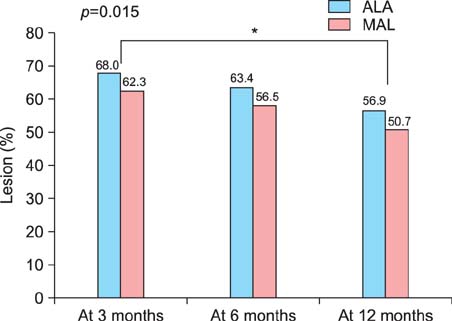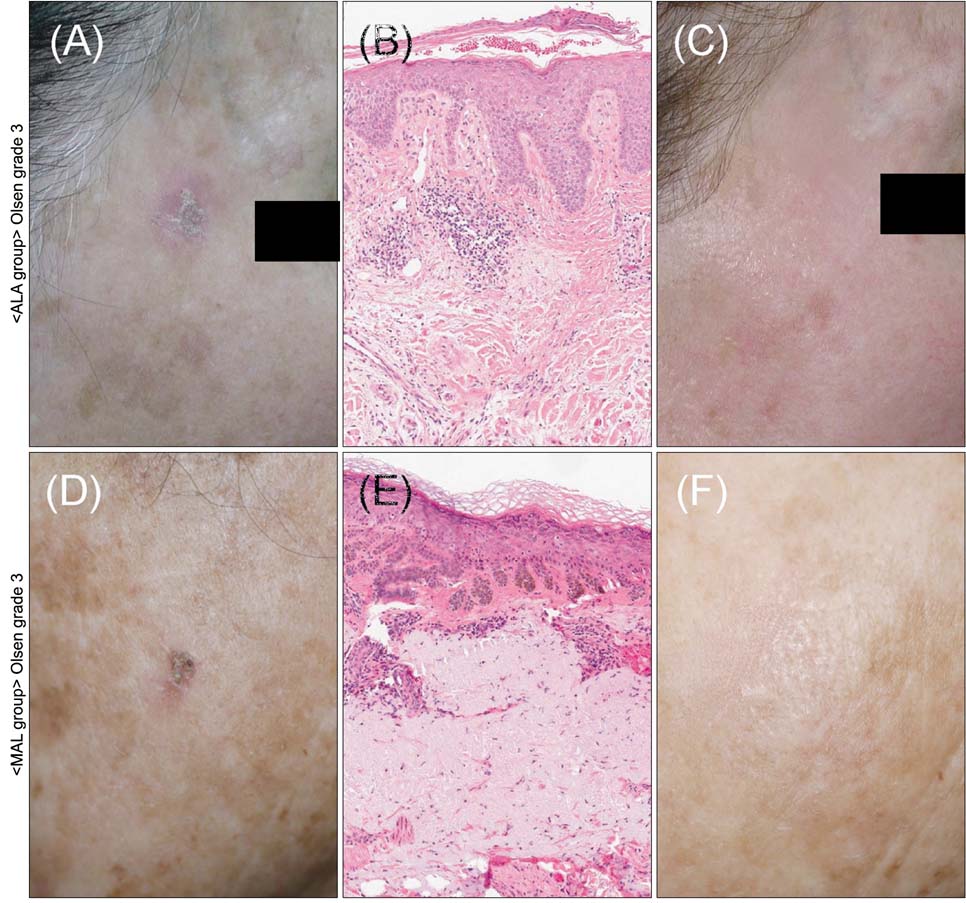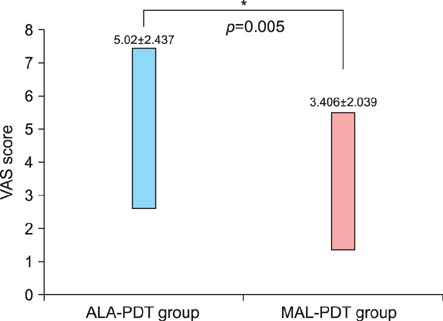Ann Dermatol.
2014 Jun;26(3):321-331.
Comparative Study of Photodynamic Therapy with Topical Methyl Aminolevulinate versus 5-Aminolevulinic Acid for Facial Actinic Keratosis with Long-Term Follow-Up
- Affiliations
-
- 1Department of Dermatology, College of Medicine, Dong-A University, Busan, Korea. khsong@dau.ac.kr
Abstract
- BACKGROUND
Few studies have compared the efficacy, cosmetic outcomes, and adverse events between 5-aminolevulinic acid photodynamic therapy (ALA-PDT) and methyl aminolevulinate-PDT (MAL-PDT) for actinic keratoses (AKs) in Asian ethnic populations with dark-skin.
OBJECTIVE
We retrospectively compared the long-term efficacy, recurrence rates, cosmetic outcomes, and safety of ALA-PDT versus MAL-PDT for facial AKs in Koreans.
METHODS
A total of 222 facial AKs in 58 patients were included in this study. A total of 153 lesions (29 patients) were treated with 5-ALA, and 69 lesions (29 patients) with MAL. ALA and MAL creams were applied for 6 hours and 3 hours, respectively; the lesions were then illuminated with a halogen lamp at 150 J/cm2 for ALA-PDT and a diode lamp at 37 J/cm2 for MAL-PDT.
RESULTS
The complete response rates of ALA-PDT and MAL-PDT were 56.9% and 50.7%, respectively, with no significant difference at 12 months after treatment. No significant difference in recurrence rates was observed between the 2 PDT modalities at either 6 or 12 months after treatment. There was no significant difference in the cosmetic outcomes between the 2 treatment modalities at 12 months after PDT. However, ALA-PDT caused significantly more painful than MAL-PDT (p=0.005). The adverse events were mild to moderate, transient, and self-limiting for both modalities.
CONCLUSION
MAL-PDT was similar to ALA-PDT in terms of long-term efficacy, recurrence rates, cosmetic outcomes, and adverse events; however, it was a significantly less painful procedure than ALA-PDT in our study.
Keyword
MeSH Terms
Figure
Reference
-
1. Salasche SJ. Epidemiology of actinic keratoses and squamous cell carcinoma. J Am Acad Dermatol. 2000; 42:4–7.
Article2. Drake LA, Ceilley RI, Cornelison RL, Dobes WL, Dorner W, Goltz RW, et al. Guidelines of care for actinic keratoses. Committee on Guidelines of Care. J Am Acad Dermatol. 1995; 32:95–98.3. Glogau RG. The risk of progression to invasive disease. J Am Acad Dermatol. 2000; 42:23–24.
Article4. Sotiriou E, Apalla Z, Maliamani F, Zaparas N, Panagiotidou D, Ioannides D. Intraindividual, right-left comparison of topical 5-aminolevulinic acid photodynamic therapy vs. 5% imiquimod cream for actinic keratoses on the upper extremities. J Eur Acad Dermatol Venereol. 2009; 23:1061–1065.
Article5. Braathen LR, Szeimies RM, Basset-Seguin N, Bissonnette R, Foley P, Pariser D, et al. International Society for Photodynamic Therapy in Dermatology, 2005. Guidelines on the use of photodynamic therapy for nonmelanoma skin cancer: an international consensus. J Am Acad Dermatol. 2007; 56:125–143.
Article6. Kennedy JC, Pottier RH. Endogenous protoporphyrin IX, a clinically useful photosensitizer for photodynamic therapy. J Photochem Photobiol B. 1992; 14:275–292.7. Gold MH. Therapeutic and aesthetic uses of photodynamic therapy part five of a five-part series: ALA-PDT and MAL-PDT what makes them different. J Clin Aesthet Dermatol. 2009; 2:44–47.8. Kloek J, Beijersbergen van Henegouwen GMJ. Prodrugs of 5-aminolevulinic acid for photodynamic therapy. Photochem Photobiol. 1996; 64:994–1000.9. Fritsch C, Homey B, Stahl W, Lehmann P, Ruzicka T, Sies H. Preferential relative porphyrin enrichment in solar keratoses upon topical application of delta-aminolevulinic acid methylester. Photochem Photobiol. 1998; 68:218–221.
Article10. Szeimies RM, Karrer S, Radakovic-Fijan S, Tanew A, Calzavara-Pinton PG, Zane C, et al. Photodynamic therapy using topical methyl 5-aminolevulinate compared with cryotherapy for actinic keratosis: a prospective, randomized study. J Am Acad Dermatol. 2002; 47:258–262.
Article11. Szeimies RM, Karrer S, Sauerwald A, Landthaler M. Photodynamic therapy with topical application of 5-aminolevulinic acid in the treatment of actinic keratoses: an initial clinical study. Dermatology. 1996; 192:246–251.
Article12. Jeffes EW, McCullough JL, Weinstein GD, Fergin PE, Nelson JS, Shull TF, et al. Photodynamic therapy of actinic keratosis with topical 5-aminolevulinic acid. A pilot dose-ranging study. Arch Dermatol. 1997; 133:727–732.
Article13. Piacquadio DJ, Chen DM, Farber HF, Fowler JF Jr, Glazer SD, Goodman JJ, et al. Photodynamic therapy with aminolevulinic acid topical solution and visible blue light in the treatment of multiple actinic keratoses of the face and scalp: investigator-blinded, phase 3, multicenter trials. Arch Dermatol. 2004; 140:41–46.14. Pariser DM, Lowe NJ, Stewart DM, Jarratt MT, Lucky AW, Pariser RJ, et al. Photodynamic therapy with topical methyl aminolevulinate for actinic keratosis: results of a prospective randomized multicenter trial. J Am Acad Dermatol. 2003; 48:227–232.
Article15. Freeman M, Vinciullo C, Francis D, Spelman L, Nguyen R, Fergin P, et al. A comparison of photodynamic therapy using topical methyl aminolevulinate (Metvix) with single cycle cryotherapy in patients with actinic keratosis: a prospective, randomized study. J Dermatolog Treat. 2003; 14:99–106.
Article16. Tarstedt M, Rosdahl I, Berne B, Svanberg K, Wennberg AM. A randomized multicenter study to compare two treatment regimens of topical methyl aminolevulinate (Metvix)-PDT in actinic keratosis of the face and scalp. Acta Derm Venereol. 2005; 85:424–428.
Article17. Szeimies RM, Matheson RT, Davis SA, Bhatia AC, Frambach Y, Klövekorn W, et al. Topical methyl aminolevulinate photodynamic therapy using red light-emitting diode light for multiple actinic keratoses: a randomized study. Dermatol Surg. 2009; 35:586–592.
Article18. Nakano A, Tamada Y, Watanabe D, Ishida N, Yamashita N, Kuhara T, et al. A pilot study to assess the efficacy of photodynamic therapy for Japanese patients with actinic keratosis in relation to lesion size and histological severity. Photodermatol Photoimmunol Photomed. 2009; 25:37–40.
Article19. Itoh Y, Ninomiya Y, Henta T, Tajima S, Ishibashi A. Topical delta-aminolevulinic acid-based photodynamic therapy for Japanese actinic keratoses. J Dermatol. 2000; 27:513–518.
Article20. Lee JS, Kim YJ, Kang HY, Lee ES, Oh CH, Kim YC. Topical photodynamic therapy for treatment of actinic keratosis using light-emitting diode (LED) device. Korean J Dermatol. 2005; 43:469–474.21. Park HS, Jin SP, Cho KH. Topical photodynamic therapy with methyl-aminolevulinic acid for the treatment of actinic keratosis. Korean J Dermatol. 2010; 48:837–843.22. Suh KS, Lee JW, Jeon YS, Kim ST. Efficacy of photodynamic therapy with methyl 5-aminolevulinic acid and red light for actinic keratosis. Korean J Dermatol. 2009; 47:633–640.23. Hirata Y, Koga S, Fukui N, Yu A, Koshida S, Kosaka Y, et al. 5-Aminolevulinic acid-mediated photodynamic therapy to superficial malignant skin tumors using Super Lizer. J Dermatol. 2011; 38:748–754.
Article24. Olsen EA, Abernethy ML, Kulp-Shorten C, Callen JP, Glazer SD, Huntley A, et al. A double-blind, vehicle-controlled study evaluating masoprocol cream in the treatment of actinic keratoses on the head and neck. J Am Acad Dermatol. 1991; 24:738–743.
Article25. Morton C, Campbell S, Gupta G, Keohane S, Lear J, Zaki I, et al. AKtion Investigators. Intraindividual, right-left comparison of topical methyl aminolaevulinate-photodynamic therapy and cryotherapy in subjects with actinic keratoses: a multicentre, randomized controlled study. Br J Dermatol. 2006; 155:1029–1036.
Article26. Kurwa HA, Yong-Gee SA, Seed PT, Markey AC, Barlow RJ. A randomized paired comparison of photodynamic therapy and topical 5-fluorouracil in the treatment of actinic keratoses. J Am Acad Dermatol. 1999; 41:414–418.
Article27. Togsverd-Bo K, Haak CS, Thaysen-Petersen D, Wulf HC, Anderson RR, Hædersdal M. Intensified photodynamic therapy of actinic keratoses with fractional CO2 laser: a randomized clinical trial. Br J Dermatol. 2012; 166:1262–1269.
Article28. Smits T, Robles CA, van Erp PE, van de Kerkhof PC, Gerritsen MJ. Correlation between macroscopic fluorescence and protoporphyrin IX content in psoriasis and actinic keratosis following application of aminolevulinic acid. J Invest Dermatol. 2005; 125:833–839.
Article29. Gerritsen MJ, Smits T, Kleinpenning MM, van de Kerkhof PC, van Erp PE. Pretreatment to enhance protoporphyrin IX accumulation in photodynamic therapy. Dermatology. 2009; 218:193–202.
Article30. Ma LW, Nielsen KP, Iani V, Moan J. A new method for photodynamic therapy of melanotic melanoma -- effects of depigmentation with violet light photodynamic therapy. J Environ Pathol Toxicol Oncol. 2007; 26:165–172.
Article31. Szeimies RM, Stockfleth E, Popp G, Borrosch F, Brüning H, Dominicus R, et al. Long-term follow-up of photodynamic therapy with a self-adhesive 5-aminolaevulinic acid patch: 12 months data. Br J Dermatol. 2010; 162:410–414.
Article32. Fritsch C, Lehmann P, Stahl W, Schulte KW, Blohm E, Lang K, et al. Optimum porphyrin accumulation in epithelial skin tumours and psoriatic lesions after topical application of delta-aminolaevulinic acid. Br J Cancer. 1999; 79:1603–1608.
Article33. Lesar A, Ferguson J, Moseley H. A time course investigation of the fluorescence induced by topical application of 5-aminolevulinic acid and methyl aminolevulinate on normal human skin. Photodermatol Photoimmunol Photomed. 2009; 25:191–195.
Article34. Tschen EH, Wong DS, Pariser DM, Dunlap FE, Houlihan A, Ferdon MB. Phase IV ALA-PDT Actinic Keratosis Study Group. Photodynamic therapy using aminolaevulinic acid for patients with nonhyperkeratotic actinic keratoses of the face and scalp: phase IV multicentre clinical trial with 12-month follow up. Br J Dermatol. 2006; 155:1262–1269.
Article35. Sotiriou E, Apalla Z, Chovarda E, Goussi C, Trigoni A, Ioannides D. Single vs. fractionated photodynamic therapy for face and scalp actinic keratoses: a randomized, intraindividual comparison trial with 12-month follow-up. J Eur Acad Dermatol Venereol. 2012; 26:36–40.
Article36. Dirschka T, Radny P, Dominicus R, Mensing H, Brüning H, Jenne L, et al. AK-CT002 Study Group. AK-CT003 Study Group. Long-term (6 and 12 months) follow-up of two prospective, randomized, controlled phase III trials of photodynamic therapy with BF-200 ALA and methyl aminolaevulinate for the treatment of actinic keratosis. Br J Dermatol. 2013; 168:825–836.
Article37. Kaufmann R, Spelman L, Weightman W, Reifenberger J, Szeimies RM, Verhaeghe E, et al. Multicentre intraindividual randomized trial of topical methyl aminolaevulinate-photodynamic therapy vs. cryotherapy for multiple actinic keratoses on the extremities. Br J Dermatol. 2008; 158:994–999.
Article38. Serra-Guillen C, Nagore E, Hueso L, Llombart B, Requena C, Sanmartín O, et al. A randomized comparative study of tolerance and satisfaction in the treatment of actinic keratosis of the face and scalp between 5% imiquimod cream and photodynamic therapy with methyl aminolaevulinate. Br J Dermatol. 2011; 164:429–433.
Article39. Kasche A, Luderschmidt S, Ring J, Hein R. Photodynamic therapy induces less pain in patients treated with methyl aminolevulinate compared to aminolevulinic acid. J Drugs Dermatol. 2006; 5:353–356.40. Rud E, Gederaas O, Høgset A, Berg K. 5-aminolevulinic acid, but not 5-aminolevulinic acid esters, is transported into adenocarcinoma cells by system BETA transporters. Photochem Photobiol. 2000; 71:640–647.
Article41. Mikolajewska P, Iani V, Juzeniene A, Moan J. Topical aminolaevulinic acid- and aminolaevulinic acid methyl ester-based photodynamic therapy with red and violet light: influence of wavelength on pain and erythema. Br J Dermatol. 2009; 161:1173–1179.
Article42. Wiegell SR, Stender IM, Na R, Wulf HC. Pain associated with photodynamic therapy using 5-aminolevulinic acid or 5-aminolevulinic acid methylester on tape-stripped normal skin. Arch Dermatol. 2003; 139:1173–1177.
Article43. Wiegell SR, Haedersdal M, Philipsen PA, Eriksen P, Enk CD, Wulf HC. Continuous activation of PpIX by daylight is as effective as and less painful than conventional photodynamic therapy for actinic keratoses; a randomized, controlled, single-blinded study. Br J Dermatol. 2008; 158:740–746.
Article44. Steinbauer JM, Schreml S, Babilas P, Zeman F, Karrer S, Landthaler M, et al. Topical photodynamic therapy with porphyrin precursors--assessment of treatment-associated pain in a retrospective study. Photochem Photobiol Sci. 2009; 8:1111–1116.
Article45. Moloney FJ, Collins P. Randomized, double-blind, prospective study to compare topical 5-aminolaevulinic acid methylester with topical 5-aminolaevulinic acid photodynamic therapy for extensive scalp actinic keratosis. Br J Dermatol. 2007; 157:87–91.
Article
- Full Text Links
- Actions
-
Cited
- CITED
-
- Close
- Share
- Similar articles
-
- Efficacy of Photodynamic Therapy with Methyl 5-aminolevulinic Acid and Red Light for Actinic Keratosis
- Topical Photodynamic Therapy for Treatment of Actinic Keratosis Using Light-Emitting Diode (LED) Device
- A Case of Actinic Cheilitis Treated by Topical Photodynamic Therapywith Methyl Aminolevulinate
- Topical Photodynamic Therapy with Methyl-aminolevulinic Acid for the Treatment of Actinic Keratosis
- A Case of Actinic Keratosis Treated by Topical Photodynamic Therapy with Low Intensity Dye Laser







